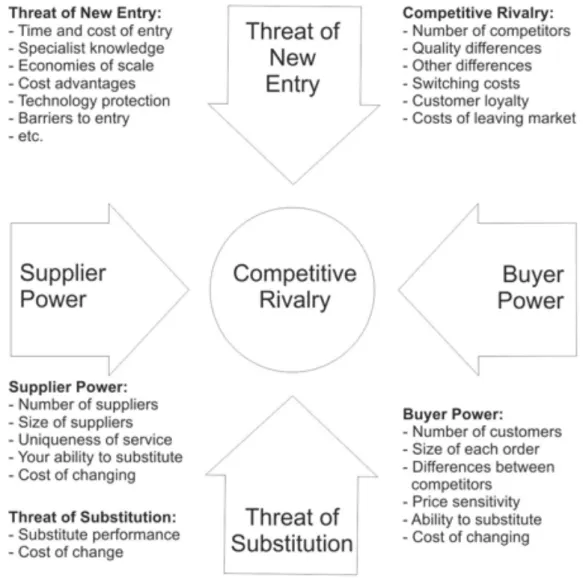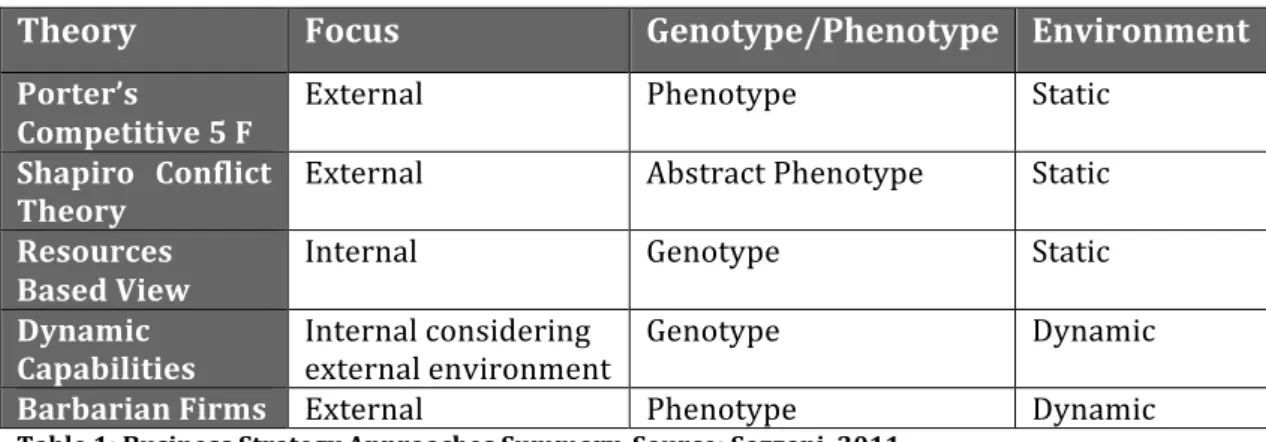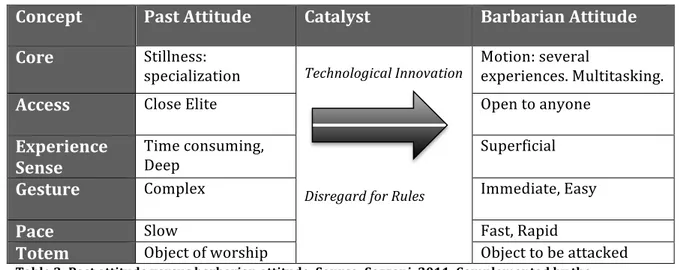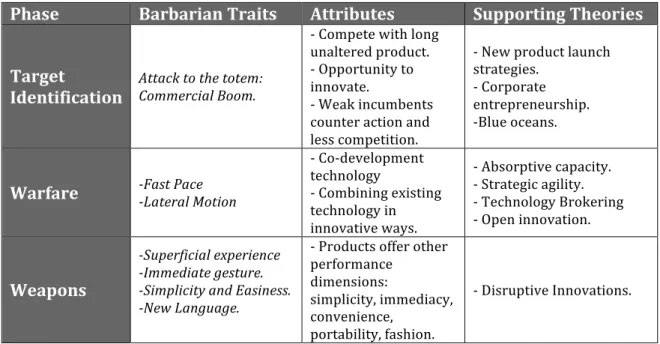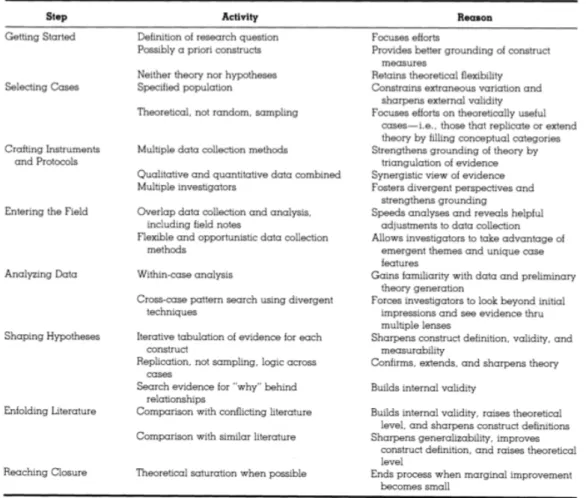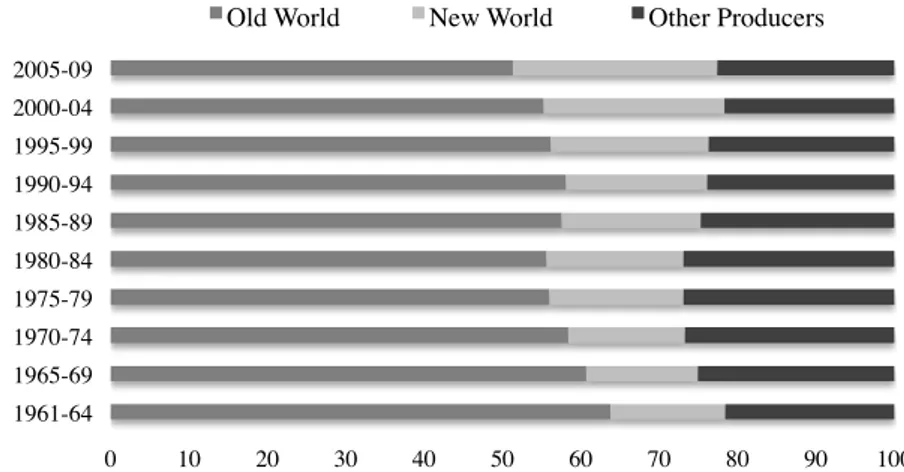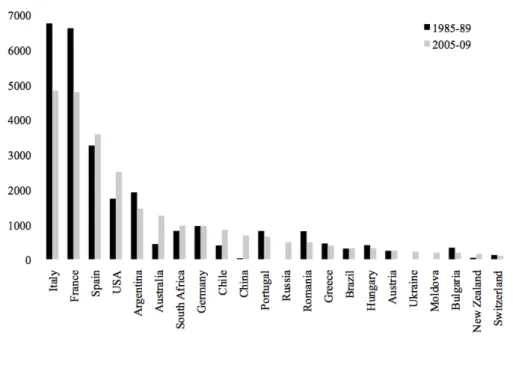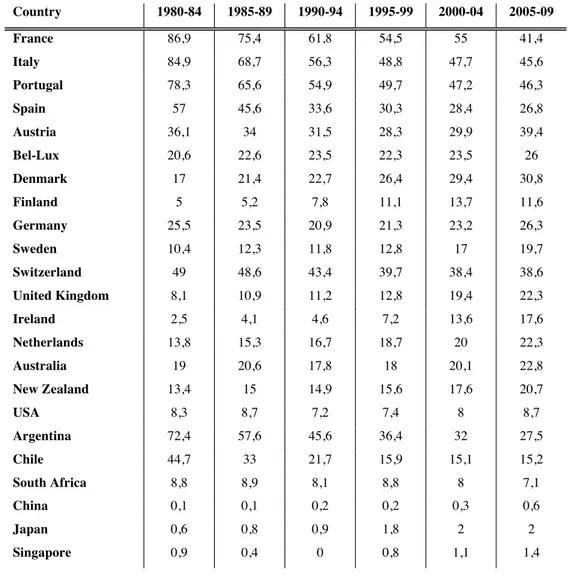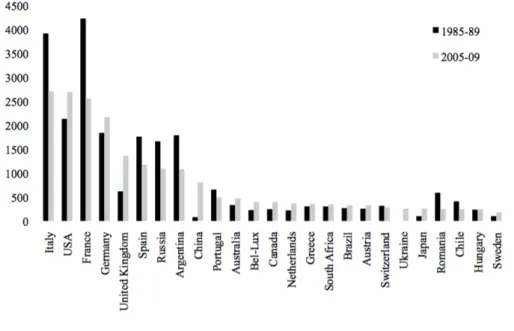POLITECNICO DI MILANO
Scuola Ingegneria dei Sistemi
MASTER OF SCIENCE IN
MANAGEMENT ENGINEERING
BARBARIAN FIRM: A PHENOTYPE FOR
COMPETING IN TURBULENT MARKETS
-A CASE IN THE WINE INDUSTRY-
SUPERVISOR: FEDERICO FATTINI.
AUTHOR: DIEGO ANDRÉS LÓPEZ GARCÍA MATRICULATION Nº: 767124
ACKNOWLEDMENTS
I would like to express my gratitude to all the people supporting me during this endeavour.
First, I like to thank to Professor Federico Frattini for his insights, advice and guidance, and all Politecnico di Milano for these two years of invaluable education.
Especially thanks to my wife and family, partners during this adventure. It is because of them that I have accomplished this huge goal.
ABSTRACT
The importance of strategic management for firms is increasing everyday since technology advancements have turned the dynamic of markets less predictable and harder to plan. Companies must to accordingly move with this dynamic if they want to keep the pace of competence and acquire possible advantages.
This paper propose a complementary approach to the already existing theories about competence, showing the external characteristics (Phenotype) of those companies more likely to succeed in highly-‐competitive markets: Barbarian Firms. Departing from the book of the Italian sociologist Alessandro Baricco “The Barbarians, an essay about mutation”, the main features (characteristics) of Barbarian Companies are depicted; though a previously review of main theories about strategic management (i.e. Five Forces, Strategic Conflict, Resources Based View and Dynamic Capabilities) is developed to find those spots where theories may be limited.
The traits of the Barbarians, namely Barbarian Phenotype leveraging companies to succeed are: attack symbols (totems) unaltered for long time, supporting this attack on technologies innovations or brokering the already existing; acquiring a dynamic motion that permits turn the direction promptly according to market trends; creating new markets, transforming the set of core values for customers, making products and services more easy, convenient, simple and spectacular. The latter is illustrated and analysed with the case of study on the wine industry, which have passed through a lot of transformations in the last decades due to the New World Producers entrance and approach to competition, respect to Old World Producers.
Finally, some conclusion and other cases of study over the same subject, and suggestions about future research to keep studying the Barbarian Firms concept are briefly shown.
RIASSUNTO
L’importanza della gestione strategica per le aziende è in aumento ogni giorno a causa delle innovazioni tecnologiche, che hanno trasformato la dinamica dei mercati meno prevedibile e più difficile di pianificare. Le aziende devono muoversi conseguente con questa dinamica se vogliono tenere il paso delle competenze e acquisire possibili vantaggi.
Il presente documento propone un approccio complementare alle teorie già esistenti sulla competenza, mostrando le caratteristiche esterne (Fenotipo) delle aziende con più probabilità di successo in mercati molto competitivi: Aziende Barbare. Partendo dal libro del sociologo Italiano Alessandro Baricco “I Barbari, un saggio sulla mutazione”, sono mostrate le principali caratteristiche delle aziende barbariche, ma prima sviluppando un controllo delle principali teorie di competenze e gestione strategica (cinque forze, conflitto strategico, vista basata su risorsi, e capacità dinamiche), per individuare quelli aspetti in cui quelle teorie possono essere limitate.
I gesti dei Barbari, cioè Fenotipo, che leva le aziende a succedere sono: attacco ai simboli (totem) che restano inalterati per lungo tempo; sostenuto questo attacco sulle innovazione tecnologiche o sull’intermediazione delle già esistenti. Così acquistano un movimento dinamico che permette di invertire la direzione prontamente secondo la tendenza dei mercati, creando nuovi, trasformando dei valori i consumatori considera centrali, rendendo i prodotti e servizi più facile, conveniente, semplice e spettacolare. Questo ultimo è illustrato e analizzato con il caso di studio sul settore del vino, cui è passato attraverso molte trasformazioni negli ultimi decenni a cause dell’ingresso e approccio alle competenze dei Produttori dei Nuovi Mondo rispetto ai Produttori dei Vecchio Mondo.
Finalmente, sono brevemente illustrati altri casi de studio sullo stesso soggetto, le conclusioni riguardo al tema, e suggerimenti alle future ricerche sulle Aziende Barbare.
TABLE OF CONTENTS
1. INTRODUCTION ... 11
2. COMPETENCE THEORY ... 15
2.1 DARWIN’S NATURAL COMPETENCE THEORY ... 15
2.1.1 Genotype ... 17
2.1.2 Phenotype ... 18
2.2 PORTER FIVE COMPETITIVE FORCES ... 18
2.2.1 Threat of New Entry ... 19
2.2.2 Intensity of competition among existing competitors ... 20
2.2.3 Pressure from Substitute products ... 20
2.2.4 Bargaining Power of Buyers ... 20
2.2.5 Bargaining Power of Suppliers ... 21
2.3 STRATEGIC CONFLICT THEORY ... 21
2.4 RESOURCE BASED VIEW (RBV) ... 23
2.5 DYNAMIC CAPABILITIES ... 25
2.5.1 Sensing Opportunities ... 26
2.5.2 Seizing Opportunities ... 27
2.5.3 Managing Threats and Reconfiguration ... 28
2.6 THEORIES LIMITATIONS ... 29
3. THE BARBARIANS: BARICCO’S CONCEPT AND MANAGERIAL POINT OF VIEW .... 33
3.1 THE BARBARIANS, AN ESSAY ABOUT MUTATION SUMMARY ... 33
3.1.1 Underlying idea of the Book ... 34
3.1.2 Sack To Villages ... 36
3.2 THE BARBARIANS TRAITS: MANAGERIAL IMPLICATIONS ... 40
3.2.1 Target Identification ... 42
3.2.2 Warfare ... 44
3.2.3 Weapons ... 46
4. CASE OF STUDY METHODOLOGY ... 49
4.1 CASE OF STUDY DEFINITIONS AND USES ... 49
4.2 DATA SOURCES ... 54
4.4 APPLICABILITY ... 59
4.5 CASE OF STUDY QUALITY ... 60
4.6 WRITING A CASE OF STUDY ... 62
5. CASE OF STUDY: WINE INDUSTRY ... 64
5.1 MARKET OUTLOOK ... 64
5.1.1 Production ... 64
5.1.2 Consumption ... 66
5.2 CHANGING THE WINE INDUSTRY ... 71
5.2.1 Technology Innovation: Air Conditioning, Standardization, Large Scale Production, New Packaging ... 71
5.2.2 Change In Consumption ... 76
5.3 COMMERCIAL BOOM -‐MARKETING AND BRANDING-‐ ... 79
5.4 DISTRIBUTION CHANNELS ... 82
5.5 NEW WORLD LARGE CORPORATIONS ... 86
6. ANALISYS UNDER BARBARIAN FIRM FRAMEWORK ... 90
6.1 TARGET IDENTIFICATION ... 90
6.1.1 Attack To Totem ... 90
6.1.2 Entrepreneurship: Globalization And Commercialization. ... 95
6.2 WARFARE ... 96
6.2.1 Strategic Agility ... 96
6.2.2 Technology Brokering ... 98
6.3 WEAPONS ... 100
6.3.1 Disruptive Innovations –Values Change-‐ ... 100
6.3.2 Linguistic Revolution ... 102
6.4 SUMMARY TABLE ... 103
7. CONCLUSIONS ... 105
7.1 ABOUT THE TOPIC IMPORTANCE ... 105
7.2 ABOUT THE RESEARCH ... 106
7.3 ABOUT BARBARIAN PHENOTYPE ... 108
7.3.1 Attack to totem ... 108
7.3.2 Lateral Movement ... 109
7.3.3 Disruptive Innovations ... 110
7.4 GENERALIZATION AND LIMITATIONS ... 112 7.5 ABOUT FURTHER RESEARCH ... 114
8. REFERENCES ... 116
8.1 BOOKS AND JOURNALS ... 116 8.2 WEBSITES ... 121
LIST OF TABLES
Table 1: Business Strategy Approaches Summary ... 32
Table 2: Past attitude versus barbarian attitude ... 40
Table 3: Barbarians Traits. ... 41
Table 4: Choosing a Research Strategy ... 51
Table 5: Process of Building a case of Study ... 63
Table 6: National Wine consumption per capita, litres. ... 67
Table 7: Share of world wine production and consumption by quality in value, 2009. ... 70
Table 8: Share of national wine sales volume by the 4 largest firms, 2009, %. .... 87
Table 9: Share of World Wine sales volume by 10 largest firms, 2009, % ... 89
Table 10: Four largest firms in each country, 2009. ... 89
Table 11: Summary Barbarian Behaviour Wine Industry ... 104
Table 12: Barbarian Firms -‐Cases of study-‐ ... 113
LIST OF FIGURES
Figure 1: Five Forces Model ... 19
Figure 2: Share of World wine production. % Volume. ... 65
Figure 3: World Wine Production by Nation, million litres ... 66
Figure 4: Volume of Beverage wine consumption, millions of litres. ... 68
Figure 5: Share of world wine exports, % Volume. ... 69
Figure 6: Examples Wine sold with different brand respect its producer. ... 93
Figure 7: Wine in can and box ... 94
Figure 8: Successful Firms Genotype and Phenotype ... 111
1. INTRODUCTION
The role of strategic management within organizations has increased its importance since last century. Competition in the global market place transformed organizations’ approach towards planning as a required endeavor to keep pace of competition, and possible way to adapt themselves to ever changing conditions.
From Porter (1980) to Eissenhart, Boyle and many other authors, strategic management have been theorized about the optimal firm’s core characteristics to compete, focusing specially upon two areas: the impact of strategic planning on firm’s performance and its decision making process; second, exploring the organizational processes of strategic formulation (Grant, 2003).
Maybe Michel Porter with his Five Forces framework was the most applied and discussed during the last two decades of 20th century. Porter, that based its theory of strategic formulation in coping with competition raising entry barriers, has been criticized because the theory is very static and sees the market structure as purely exogenous (Eissenhart & Martin, 2000). In the same line, Shapiro theorizes about business strategy as a game of action and reaction of incumbents within a specific market (Shapiro, 1989). The intensity of the rivalry for Shapiro relies in the capability of the firm’s to rapidly respond to the different movements of its competitors in an efficient and effective way.
Later, other authors devote more emphasis in the internal structure of companies and settled that its competitive position is depends on its ability to explode internal capabilities, valuable and non-‐easy to imitate resources (Barney, Mauhanna & Ray, 2004). Resource-‐based logic suggests that business processes exploiting valuable but common resources are source of competitive parity; business processes exploiting valuable and rare resources can be a source of temporary competitive advantage; and business processes exploiting valuable,
rare, and costly-‐to-‐imitate resources can be a source of sustained competitive (Barney, Mauhanna & Ray, 2004).
Nevertheless, companies fail thinking that strategic planning is a calendar driven ritual, and assuming that the future will be more or less like the present (Grant, 2003). Nowadays, increasing volatility of business environments makes the strategic planning process more difficult; rapid change requires strategies to be flexible and creative, thus formalisms in strategy settling become useless.
High-‐velocity markets are those in which market boundaries are blurred, successful business models are unclear, and market players (i.e., buyers, suppliers, competitors, complementers) are ambiguous and shifting. The overall industry structure is unclear. In these markets, dynamic capabilities necessarily rely much less on existing knowledge and much more (Eissenhart, 2011).
The challenge of making strategy when the future is unknowable encourage reconsideration of both processes of strategy formulation and the nature of organizational strategy. Attempts to reconcile systematic strategic planning with turbulent, unpredictable business environments may include scenario planning, strategic innovation, complexity and self-‐organization (Grant, 2003).
In this regard, business strategic management to compete in turbulent and dynamic environments becomes more important for firms. In spite of traditional strategic theories such as the five forces (Porter, 1980) or the strategic conflict theory (Shapiro, 1989) had proved efficient to explain how firms could achieve competitive advantage, they appeared however quite inadequate to explain how firms could sustain it under disruptive, fast or complex change. The growing dynamicity of the business environment has therefore led to significant revisions in business priorities, strategic visions, and in the viability of conventional and contemporary models (Shafari & Zhang, 1999).
Markets are now more unpredictable and dynamic. New Technologies have transformed the pace of competence and the way of gaining and sustaining
competitive advantage. Evolutions of markets due to technology advancements force firms to rapidly adapt themselves to new conditions or fail. Therefore, it seems that Charles Darwin’s ‘Theory of Species’ applies to business strategy: new companies adapting their processes, products and services prevail over long lasting incumbents that denied to change or did not understand the signs of markets and consumers. For instance, Nokia was the worldwide cellphone’s producer leader, relying its competitive advantage in the reliability of its devices and battery’s duration. Today, after five or six years of changes and intense competition, Apple iPhone and Samsung are market leaders with a different value offer, adapting their products including new functionalities, specially in software (operating systems and applications), and transforming those previously core characteristics in secondary, thus less important for customers at the moment of purchase.
In this sense, the main firms features or traits making them to prevail on turbulent markets are now particularly important to be recognized. Characteristics allowing firms to adapt themselves to turbulent and highly competitive environments.
Considering Darwin’s theory, species with special set of internal and external characteristics, able to adapt the most to new environment conditions, are those more likely to survive in competitive contexts. Metaphorically speaking the ‘Genotype’ are the internal characteristics, genes or essential features of firms making possible to survive, adapt and compete successfully within environments where resources (customers) are competed. The latter, portrayed by scholars like Teece and colleagues (1997) as Dynamic Capabilities, associated with a firm-‐ level characteristics and recurrent behaviors like flexibility, velocity, collaboration attitude, ability to create and exploit connections (Frattini, 2011). In contrast, the external manifestations or ‘physical characteristics’ of these genetic map, namely ‘Phenotype’ has not been clearly studied. Successful companies need a set of specific characteristics to survive in harsh environments, characteristics that should be recognized and individualized in order to understand how to compete and sustain advantages in the long term.
Given this discussion, the aim of this paper is to illustrate the firms’ external characteristics -‐Phenotype-‐ making them possible to successfully compete in turbulent and highly competitive environments. In other words, the question to be solved with this research is:
Which is the observable set of external characteristics within firms making possible to successfully compete in highly competitive environments?
Departing from the academic work already done by Audran (2010) and Sozzani (2011), published within Politecnico di Milano and Stockholm School of Economics, this research is developed. Taking as a cornerstone the Alesandro Baricco’s book “The Barbarians, an essay about mutation”, which analyzes the current transformation in society behavior from a sociological point of view, and interpreting it in managerial sense, behavior of firms’ able to successfully compete in dynamic markets is conceptualized. Later on, the idea behind the ‘Barbarian Firm’s behavior’ is illustrated through a case of study about the transformation of the wine industry during the last years, showing how the competence and conditions within this industry has changed since the ‘Barbarians’ entrance in this market area.
The paper is organized in the following schema: First, a brief review about business strategies theories is made, showing their possible limitations, which are intended to be covered by this project with the ‘Barbarians’ theory. Second, the ‘Barbarian’ concepts are presented, summarizing the most important parts of Alessandro Baricco’s book and conceptualizing them under a managerial point of view. Third, the methodology regarding cases of study as managerial tool to present novel concepts is illustrated. Finally the case of study around the wine industry is presented and analyzed under ‘Barbarian’ framework to validate these concepts and explain the transformations within the industry.
2. COMPETENCE THEORY
The fundamental question in the field of strategic management is how firms achieve and sustain competitive advantage (Teece, Pisano & Shuen, 1997). Theories about competition are several and they have varied according to different approaches, moments and firms behaviours, some of them considering external factors, others internals, and finally some of them with a mix point of view.
This chapter briefly presents some different approaches to competition and competitive advantage. Departing the most antique theory of competition, Darwin’s Natural Selection to Porter’s theory (rooted in industrial organization), Shapiro, Teece, Barney and their colleagues, a framework about the most important competition theories will be briefly presented.
In spite of common use and applicability of these theories within strategic management, scholars are continuously asking themselves their validity due to some static underlying assumptions about positioning and entry barriers, which has became it clearly inadequate (Bianchi, Chiesa & Frattini, 2011).
Finally, and having a broad view of these theories, a general idea about why these theories don’t fulfil all the requirements to analyse the competition in turbulent environments as we have nowadays is presented.
2.1 DARWIN’S NATURAL COMPETENCE THEORY
Darwin’s original contributions were the mechanism of natural selection and copious amounts of evidence for evolutionary change from many sources. He also provided thoughtful explanations of the consequences of evolution for our understanding of the history of life and modern biological diversity (Michigan University, 2010).
Talking about competition, Darwin states that competition exists among individuals. Regardless of the rate of reproduction in a species, all of the young do not survive to become reproducing adults. This fact indicates that large numbers of offspring somehow are eliminated from the population. Some certainly die by accident. But most of them succumb to competition with other individuals. The most intense competition may be among individuals of the same species who compete for nearly identical environmental requirements. Competition may be as simple as a race to get a rabbit — the first fox there gets lunch; the others go hungry. Competition may involve obtaining a choice nesting site, or being able to find the last available hiding hole when a bigger fish comes looking for dinner. Those individuals who catch the rabbit or find the hiding hole survive to pass on their genes to the next generation (American Geoscience Institute, 2010).
From one generation to the next, the struggle for resources (what Darwin called the “struggle for existence”) will favour individuals with some variations over others and thereby change the frequency of traits within the population. This process is natural selection. The traits that confer an advantage to those individuals who leave more offspring are called adaptations (Michigan University, 2010).
In order for natural selection to operate on a trait, the trait must possess heritable variation and must confer an advantage in the competition for resources. If one of these requirements does not occur, then the trait does not experience natural selection. Natural selection operates by comparative advantage, not an absolute standard of design. “…as natural selection acts by competition for resources, it adapts the inhabitants of each country only in relation to the degree of perfection of their associates” (Darwin, 1859).
During the twentieth century, genetics was integrated with Darwin’s mechanism, allowing us to evaluate natural selection as the differential survival and reproduction of genotypes, corresponding to particular phenotypes. Natural
selection can only work on existing variation within a population. Such variations arise by mutation, a change in some part of the genetic code for a trait. Mutations arise by chance and without foresight for the potential advantage or disadvantage of the mutation (Michigan University, 2010).
Metaphorically speaking, Darwin’s Theory applies to strategic management; it shows how important are evolution, adaptations and mutations for firms to survive when competing for resources (customers). Nowadays, more companies are likely to fail given that the struggle is even harder: more products, different set of value offers and diverse kind of customers. That’s why is very important to recognize, as Darwin’s states, the Genotype and Phenotype characteristics of the most capable species to survive in harsh environments.
2.1.1 Genotype
This is the "internally coded, inheritable information" carried by all living organisms. This stored information is used as a "blueprint" or set of instructions for building and maintaining a living creature. These instructions are found within almost all cells (the "internal" part), they are written in a coded language (the genetic code), they are copied at the time of cell division or reproduction and are passed from one generation to the next ("inheritable"). These instructions are intimately involved with all aspects of the life of a cell or an organism. They control everything from the formation of protein macromolecules, to the regulation of metabolism and synthesis (Brooklyn College, 2000).
In this paper, genotype refers to the set of internal characteristics of companies making possible to successfully compete within dynamic markets. Dynamic Capabilities theory, hereafter summarized, applies adequately to describe the companies’ genotype competing successfully in turbulent environments; this paper attempts to find out what is the external manifestation of these especial internal characteristics of firms, that’s Phenotype.
2.1.2 Phenotype
This is the "outward, physical manifestation" of the organism. These are the physical parts, the sum of the atoms, molecules, macromolecules, cells, structures, metabolism, energy utilization, tissues, organs, reflexes and behaviors; anything that is part of the observable structure, function or behavior of a living organism (Brooklyn College, 2000).
As the purpose of this research is aims to find the firm’s external characteristics necessary to successfully compete in dynamic environments, metaphorically the term ‘Phenotype’ is used from now on. If it is compared the competition among firms to the natural selection proposed by Darwin, the importance of studying the phenotype emerges, since natural selection firstly acts on the phenotype of species modifying their external characteristics (Sozzani, 2011). In this regard, phenotype analysed here to assess the ‘physical appearance’ of those firms more able to adapt themselves, turn upon markets needs and trends direction, better perform, thereby more able to compete and survive.
2.2 PORTER FIVE COMPETITIVE FORCES
Several theories in Strategic management can be found, all of them widely discussed; during the 80’s those theories were highly diffused, especially authors like Porter and Shapiro, which explained the different of forces that should companies consider when seeking favourable position within markets they compete in. Porter (1980), with his five forces model opens a new path to analyse competitive arenas, define corporate positions and how to defend itself against these forces or influence them in its favour (Porter, 1998).
The five forces’ main elements can be seen in the Figure 1. Since Porter, most of the analysis that aims to determine intensity in competition within industries, countries, in the academy or in the real world, taking five forces as baseline became common.
Figure 1: Five Forces Model. Adapted from Porter, 1980.
2.2.1 Threat of New Entry
New entrants to and industry bring new capacity, the desire to gain market share, and often-‐substantial resources. This threat of entry depends on the barriers to entry that are present, coupled with the reaction from existing competitors that the entrant can expect. If barriers are high and/or the newcomer can expect sharp retaliation from entrenched competitors, the threat of entry is low (Porter, 1998).
Six are the major sources of entry barriers: Economies of scale, product differentiation, capital requirements, switching costs, access to distribution channels, cost disadvantage independent of the scale, government policy (Porter, 1998).
2.2.2 Intensity of competition among existing competitors
According to Porter: “Rivalry among existing competitors takes the familiar from jockeying for position –using tactics like price competition, advertising battles, product instructions, and increased customer service and warranties. Rivalry occurs because one or more competitors either feels pressure or sees opportunities to improve its position” (Porter, 1998).
The most important factors when intensity of competition among existing competitors is analysed are: Number and balance of competitors, industry growth, fix and storage costs (how high are they?), differentiation and switching costs, capacity augmented in large increments, diverse competitors, strategic stakes, and exit barriers (Porter, 1998).
2.2.3 Pressure from Substitute products
The role of substitute products within an industry is placing a ceiling on the prices firms, limiting returns and thus profitability. The more attractive price-‐ performance alternative offered by substitutes, the stronger the ceiling in the industry profits (Porter, 1998).
2.2.4 Bargaining Power of Buyers
Buyers perform a critical role in competition forcing down the prices, bargaining for higher quality or more services, and playing competitors against each other. The buyer power (or a group of them) is powerful if it holds the following characteristics: it is concentrated or purchase large volume relative to seller
sales; the product it purchases from the industry represent a significant fraction of the buyer’s cost or purchases; the product it purchases from the industry are standard or undifferentiated; it earns low profits; buyers pose a credible threat of backward integration; the industry product is unimportant to the quality of the buyers’ products or services; finally, if the buyer has full information (Porter, 1998).
2.2.5 Bargaining Power of Suppliers
The power of the supplier relies in the fact that it can raise prices or reduce the quality of purchased goods or services; like this threatening the company or industry position. Powerful suppliers can thereby squeeze profitability out of an industry unable to recover cost increases in its own prices (Porter, 1998).
A supplier group is powerful if: it’s dominated by a few companies and it’s more concentrated than the industry it sells to; it’s not obligated to contend with other substitute products for sale to the industry; the industry is not an important customer of the supplier group; the supplier’s product is an important input to the buyer’s business; the supplier group’s product is differentiated or it has built up switching costs; and finally if the supplier group poses a credible threat of forward integration (Porter, 1998).
2.3 STRATEGIC CONFLICT THEORY
The strategic conflict theory developed by Shapiro analyzes strategic behavior departing from game theory. For him, only game theory provides a coherent and logical way to analyze firm’s behavior, which seeks to maximize profits and performs non-‐cooperatively; additionally, considering a common knowledge shared by all participants. (Shapiro, 1989).
Defining business strategy, Shapiro says: “By the theory of business strategy I mean the growing collection of models of business rivalry along many
dimensions in concentrated markets. The timing of strategic decisions and the ability of large firms to make commitments are the key to understanding business strategy” (Shapiro, 1989); pointing up the importance of markets’ concentration, time and resource commitments as core issues to define business strategy.
The main thrust of work in this tradition is to reveal how a firm can influence the behavior and actions of rival firms and thus the market environment. Examples of such moves are investment in capacity, R&D, and advertising. To be effective, these strategic moves require irreversible commitments. The moves in question will have no effect if they can be costlessly undone. A key idea is that by manipulating the market environment, a firm may be able to increase its profit. (Teece, Pisano & Shuen, 1997).
In this sense, Shapiro defines the strategic variables to be analyzed when defining or assessing the business strategy of a firm in a given market place:
Investment in physical capital. Referring to the investment that tends to
reduce marginal costs and also a strategic role cause must be observable by the rival firms. The core intention is to excel in the market forcing rival firms to compete less strongly or step out of the market (Shapiro, 1989).
Investment in intangible assets. Activities like learning by doing, R&D,
licensing, joint ventures, etc., can give the opportunity to firm to gain competitive advantage especially in high tech industries, since those kind of activities define the dynamic of the competition (Shapiro, 1989). For instance, R&D activities leading to patenting may discourage the potential entry of competitors (Gilbert & Newberry, 1982).
Strategic control of information. Having valuable and differentiated
information respect to rivals, make firms to affect the beliefs of their rivals about market conditions. For instance, it can be used for purposes of rival’s entry
deterrence, since pre entry actions may affect (potential) entrants' beliefs about the profitability of entering the market (Shapiro, 1989).
Horizontal Mergers. When looking for assets consolidations in the industry
mergers modify competence’s conditions within the market. Mergers lead to synergies, price, and thus profitability modifications (Shapiro, 1989).
Network competition and product standardization. Especially in computing
and telecommunication sectors, compatibility and standardization became critical forcing firms to modify their strategy and consolidate networks to be able to compete. (Shapiro, 1989).
Contracting. Singing long-‐term contracts became a suitable tool for firms to
deter possible competition. Consequently the interest on contracts is increasing as strategic tool with wide utility. (Shapiro, 1989).
Other dimensions. Complementary, thanks to the flexibility of business
strategies, other dimensions are important to be taken into consideration. For instance switching costs, or product and price selection; aspects that clearly can alter the conditions in which firms are competing and the pressure over the market. (Shapiro, 1989).
2.4 RESOURCE BASED VIEW (RBV)
After Porter had a deep impact in business strategy theories analyzing external environment, stating that companies profitability and positioning depends on the industry characteristics; some other authors like Barney, Mauhanna, Ray, Eissenhart, Welnerflet, commenced to discuss about the role played by firm’s internal and idiosyncratic characteristics (resources) as a determinant of its position and profitability, as a source of competitive advantage. The latter knew as Resource Based View model that it is briefly summarized hereafter as another approach to competition.
The resource-‐based approach sees firms superior systems and structures being profitable not because they engage in strategic investments that may deter entry and raise prices above long-‐run costs, but because they have markedly lower costs, or offer markedly higher quality or product performance. This approach focuses on the rents accruing to the owners of scarce firm-‐specific resources rather than the economic profits from product market positioning (Teece, Pisano & Shuen, 1997).
Firm resources, defined “as those tangible or intangible assets which are tied semi-‐permanently to the firm; for example brand names, in-‐house knowledge of technology, employment of skilled personnel, trade contracts, machinery, efficient procedures, capital, etc.” (Wernerfelt, 1984). Those resources and
capabilities working as mean to develop and implement strategies, which together with firm’s business processes accomplish firm’s purpose or objective. (Leonard & Barton, 1992).
Furthermore, differential resources work as mechanism to erect entry barriers, since the holder of a distinctive resource can affect adversely cost and revenues of later acquires. The latter called resource position barriers (Wernerfelt, 1984).
At the most basic level, such resources must be valuable (i.e., rent producing) and non substitutable (Barney, 1991; Dierickx & Cool, 1989). In other words, for a resource to have enduring value, it must contribute to a firm capability that has competitive significance and is not easily accomplished through alternative means. Next, strategically important resources must be rare and/or specific to a given firm (Barney, 1991;Reed & DeFillippi, 1990). That is, they must not be widely distributed within an industry and/or must be closely identified with a given organization, making them difficult to transfer or trade (e.g., a brand image or an exclusive supply arrangement). Although physical and financial resources may produce a temporary advantage for a firm, competitors or new entrants often can readily acquire them on factor markets. Conversely, a unique path
through history may enable a firm to obtain unusual and valuable resources that cannot be easily acquired by competitors (Barney, 1991).
In RBV competitive advantage can be sustained only if resources that are not easily duplicated by competitors support the capabilities creating the advantage. In other words, firms' resources must raise "barriers to imitation" (Hart, 1995). In this regard, sustainable competitive advantage based on the resources perspective depends on the results of the accumulation and deployment managerial choices, combined with the industry factors and market imperfections (Oliver, 1997).
Additionally, scholars like Gautam, Barney, Waleed, Mauhanna establish that resources, by themselves, cannot be a source of competitive advantage. That is, resources can only be source of competitive advantage if are used to “do something” i.e., if those resources are exploited through business processes (Barney, Mauhanna & Ray, 2004).
Finally, the optimal growth of the firm involves a balance between exploitation of existing resources and development of new ones (Wernerfelt, 1984). Firms usually fail to efficiently and effectively translate their resources and capabilities into business processes cannot expect to realize the competitive advantage potential of these resources (Barney, Mauhanna & Ray, 2004).
2.5 DYNAMIC CAPABILITIES
Another approach to competition based in firms’ internal capabilities, and that may complement the Resource Based View is Dynamic Capabilities approach. Firstly theorized by Teece (1997) and then commented by other authors as Eissenhart an Martin (2000), aims to explain those capabilities, resources and mechanism a company needs to acquire competitive advantage and sustain it over time. Nonetheless, Dynamic Capabilities left behind the static vision of the Resources Based View, addressing in its analysis rapidly changing environments.
Teece and colleagues define dynamic capabilities as “ the firm ability to integrate, build and reconfigure internal and external competences to address rapidly changing environments” (Teece, Pisano & Shuen, 1997); ability pointing to gain competitive advantage given a specific market position (Leonard & Barton, 1992).
Given the global competition, characterized by the dispersion of the innovation and manufacturing sources, sustainable advantage requires unique and difficult to replicate dynamic capabilities with the purpose to continuously create, extend, upgrade, and protect the relevant enterprise’s asset base (Teece, J., 2007).
In his first discussion Teece set three main roles of the organizational processes required to develop Dynamic capabilities: First, coordination and integration, referred to the understanding of the firm’s processes in order to adapt successfully new technology (static concept). Second, learning through possible partnerships and collaboration as a source of new organizational learning (dynamic concept). And third, reconfiguration and transformation, as the ability to perform the necessary adjustment required by the markets to be ahead of the competition (Teece, Pisano & Shuen, 1997).
Posterior to this first approach, the Dynamic Capabilities theory was enhanced by Teece himself, summarizing with analytical purpose his theory in 3 basic capabilities: (1) to sense and shape opportunities and threats, (2) to seize opportunities, and (3) to maintain competitiveness through enhancing, combining, protecting, and, when necessary, reconfiguring the business enterprise’s intangible and tangible assets (Teece, 2007).
2.5.1 Sensing Opportunities
be continuously aware, scanning, creating, learning and interpreting market signals (Teece, 2007). Firms detect these opportunities because 2 main factors: entrepreneurs can have access to privileged information (Kirzner concept), or they create new information/knowledge creating opportunities -‐Shumpeter concept-‐ (Teece, 2007).
In this regard, maybe the most important ability required by managers is how to interpret and develop new events, which technologies pursue and which market segments to target. They must assess how technology will change the landscape, and when the competitors, supplier and customers will respond (Teece, 2007).
Resource Based View emphasizes the development of management capabilities and difficult to imitate combination of organizational, functional and technological internal skills in order to acquire competitive advantage (Eissenhart & Martin, 2007). In contrast, dynamic capabilities recognizes that the time for creating opportunities only with external search and technology acquisition is over, now that as Chesbrough (2003) explains, ‘Open Innovations’ in now mandate for sense and shape firm’s success (Teece, 2007).
2.5.2 Seizing Opportunities
Seizing or exploiting opportunities involves the concept of timing, since once opportunities are available, firm’s should heavily invest in the particular technologies and design most likely to achieve marketplace acceptance (Teece, 2007).
Nevertheless, seizing firm’s opportunities not only regards to when, where, and how much to invest, but also select and create the business model that describes its commercialization strategy and investment priorities. Dynamic capabilities emerge around the manager’s ability to correctly establish decisions rules and resources allocation (Teece, 2007).
2.5.3 Managing Threats and Reconfiguration
In order to acquire or maintain the competitive advantage achieved by the identification and exploitation of the market opportunities, manage the common threats and permanently improving is required.
Enterprise’s biases can spoil performances and ruin market possibilities, impeding develop radical innovations, since those challenge the status quo. For instance ‘anti-‐cannibalization’ bias is a particular manifestation of incentive and structural problems that can thwart innovation in established enterprises (Teece, 2007). To overcome this kind of threats and continuously transform the firm’s processes to adapt themselves to customer needs, dynamic capabilities display 3 main necessary abilities into the organizations: (1) decentralization and decomposability, to gain fast decision making processes and avoid biases; (2) cospecialization, since combination of strategic assets can create or enhance special value for the firm; (3) learning, knowledge and corporate governance, which assists the technology flow and protection (intellectual property), retain the more committed talent, design reward systems, and develop corporate culture.
Finally Teece summarizes Dynamic Capabilities approach in a simple but clear way:
“The dynamic capabilities framework endeavours to explicate new strategic considerations and the decision-‐making disciplines needed to ensure that opportunities, once sensed, can be seized; and how the business can be reconfigured when the market and/or the technology inevitably is transformed once again”. (Teece, 2007).
2.6 THEORIES LIMITATIONS
It’s quite difficult to assess theories from different moments and different contexts, since all of the abovementioned theories are coming when business strategy regards what authors consider more determinant to gain competitive advantages. Nevertheless, the considerations that can be done around those theories consist in their focus, whether they study the external or internal competitive conditions and competences, and whether these theories have a static or dynamic approach.
Within the theories considered, there is not a single one that considers all those elements together, and consolidates a broad theory for strategic management and competitive advantage. The reasons can be numerous, though it can be said that all of them are complementary.
Taking as starting point the paper developed by Sozzani in 2011 about Barbarians Firms and their phenotypic characteristics, hereafter the main critics around Porter, Shapiro, Barney, Eissenhart, Teece and others theories and discussions, are presented in order to introduce the validity of the concept of Barbarians Firms and Alessandro Baricco’s theory as significant complement theory, which can enhance the comprehension around business strategy management, specially in highly dynamic and turbulent markets.
Porter states that firms’ position and competitive advantage rely in the conditions of the external environment, the dimension and intensity of the five forces running in the market (Porter, 1980). Awfully, Porter’s theory does not call attention to two important factors: first, firm’s endogenous factors as innovation and learning that are important factors to shape the market place, cope with competition and gain competitive advantage (Teece, 2007); second, Five Forces theory is purely static and does not consider dynamic environments.
Additionally, Porter relies in entry barriers as a basis to protect competitive advantage, though as some scholars have suggested (Namwoon & Hong-‐Bumm,
